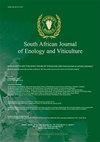干热环境下近等水和各向水葡萄叶片光合适应能力及光化学行为
IF 1.1
4区 农林科学
Q4 FOOD SCIENCE & TECHNOLOGY
引用次数: 6
摘要
研究了夏季高温干燥条件下葡萄叶片对高紫外线辐射的光合和光化学适应性,研究了近等水合的歌海娜(Grenache)和近各水合的大葡萄(Bovale grande)。从豌豆大小阶段到收获阶段,将轻度至中度水分亏缺的葡萄树进行紫外线阻断处理(-UV),并与暴露在阳光下的对照(C)进行比较。监测冠层光和热小气候、生长和密度、最大叶片气体交换、初级光化学(PSII)和酚类物质。在紫外线照射下,白天和夜间林冠温度的平均增量分别为Bovale grande的3.3°C和0.8°C, Cannonau的2.6°C和1.1°C。在C和-UV处理下,不同品种的叶面积、内在水分利用效率和茎水势基本一致。在高温和中度水分胁迫下,甘露的气孔导度较低,净同化和蒸腾速率最大,但PSII恢复较快。紫外辐射对叶片同化的影响更强、时间更长,但在−UV下持续高温会导致更高的光抑制和更低的光化学效率。叶片温度与气体交换在不同品种和处理间也有相似程度的相关关系。在c条件下,由于高温导致PSII长时间光失活,油梨叶片花青素含量下降。相反,牛蒡的酚类含量稳定性更高,因此PSII功能单元的光保护和恢复能力也更高。影响叶片酚积累的农艺措施影响冠层对高温和高日照的适应。葡萄园管理必须避免过度的树冠阳光照射和持续的高温,以促进高度同化,同时减少光失活和热损伤。本文章由计算机程序翻译,如有差异,请以英文原文为准。
UV Light Acclimation Capacity of Leaf Photosynthetic and Photochemical Behaviour in Near-isohydric and Anisohydric Grapevines in Hot and Dry Environments
The photosynthetic and photochemical adaptation of grapevine leaves to high UV radiation, under hot and dry summer conditions, was investigated in near-isohydric Cannonau (syn. Grenache) and nearanisohydric Bovale grande (syn. Carignan). From pea-size stage until harvest, vines with mild to moderate water deficit were subjected to UV-blocking treatment (–UV) and compared to a control exposed to sunlight (C). Canopy light and thermal microclimate, growth and density, maximum leaf gas exchange, primary photochemistry (PSII) and phenols were monitored. Average increments in canopy temperature under –UV tunnels during day-time and night-time were 3.3°C and 0.8°C in Bovale grande and 2.6°C and 1.1°C in Cannonau. Cultivars reached similar leaf area, intrinsic water-use efficiency and stem water potential under C and –UV. Cannonau showed lower stomatal conductance, maximum net assimilation and transpiration rates, but also faster recovery of PSII under heat and moderate water stress. UV radiation induced a stronger and longer impact on leaf assimilation, but the duration of elevated temperatures under −UV induced higher photoinhibition and lower photochemical efficiency. A similar degree of correlation between leaf temperature and gas exchange was found among cultivars and treatments. In Cannonau, leaf anthocyanin decreased due to heat-induced long-lasting PSII photoinactivation under C. Conversely, Bovale grande showed higher phenolic content stability, thus higher photoprotection and recovery of PSII functional units. Agronomical practices affecting leaf phenolic accumulation influence canopy acclimation to heat and high sunlight. Vineyard management must avoid excessive canopy sun exposure and duration of elevated temperatures to favour high assimilation, while reducing photoinactivation and heat damage.
求助全文
通过发布文献求助,成功后即可免费获取论文全文。
去求助
来源期刊
CiteScore
2.50
自引率
7.70%
发文量
1
审稿时长
>36 weeks
期刊介绍:
The South African Journal of Enology and Viticulture (SAJEV) publishes full-length original Research Papers, Research Notes and Review Papers on all subjects related to enology and viticulture. The SAJEV does not accept articles published in, or submitted to, other journals.

 求助内容:
求助内容: 应助结果提醒方式:
应助结果提醒方式:


